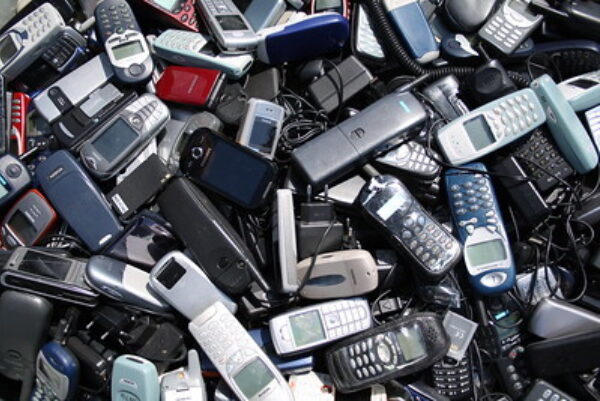Dieser Beitrag wurde im Rahmen von Scimpact geschrieben. Scimpact ist
das Förderprogramm von Reatch für junge Menschen, die Wissenschaft in
gesellschaftliche Debatten einbringen wollen.
Switzerland is one of the global leaders in recycling electronic waste (e-waste), as over 90% of e-waste is recycled. However, when it comes to sustainability and reducing the pressure on our Earth’s finite raw materials, reducing consumption is equally, if not more important than recycling what we are finished using.
93% of the Swiss population owns a smartphone, and most buy a new phone every 3 years, usually because they want a newer model or their old device is not usable anymore. Only 7% opt for a repaired or second-hand phone, mainly due to concerns about the potentially shorter lifespan of a used phone compared to a new one. However, between 50 and 90% of the carbon emissions during the life cycle of a mobile phone (depending on the model) come from its production and disposal, not its use, highlighting what a difference reducing consumption can make.
The repairability barriers inherent to many smartphones and other electronics also play a role in how often they need to be replaced. Indeed, many electronic devices are not easily repaired, or designed to be. Single components can be difficult to switch out for new ones, and devices may not even be openable with professional tools. Furthermore, software support is also finite, and many end up having to replace devices like smartphones because new software is no longer supported, not because the device itself is broken.
Fighting for the ‘right to repair’
The ‘right to repair’ movement advocates for legally giving consumers the power to ask producers for repair of products. The movement is particularly strong in Europe, though countries such as the United States and India are also getting started. In 2021, France introduced a ‘repairability index’ for appliances including smartphones, televisions and washing machines to promote repair and reduce the sale of short-lived electronics. The European Union plans to introduce such an index for smartphones and tablets in 2025. A 2020 survey of over 2,600 Swiss people showed that a ‘repairability’ label on electronic devices is highly desired, but how is the progress for ‘right-to-repair’ in Switzerland?
The Swiss Federal Council has expressed support for a circular economy initiative proposed by the Parliament, which included a possible repairability index implementation, though discussions around the proposal are ongoing at the time of writing. Consumers can also opt for devices designed to be repairable, like a Fairphone. Fairphones are designed in a way to promote the replacement of different parts, increasing their repairability, but currently make up only a small fraction of the mobile phone market in Switzerland. In the meantime, frustrated by mountains of avoidable e-waste, many turn to do-it-yourself approaches to repair devices and reduce waste.
One ‘right to repair’ enthusiast is Ken Pillonel, a freelance hardware prototyping consultant and EPFL Robotics graduate. His YouTube channel documents his adventures in electronics repair, such as replacing the battery of his Apple AirPods which are designed to be unrepairable. According to Pillonel, improving the repairability of electronic devices on a local scale “would also align with Swiss values of sustainability and environmental responsibility, by reducing electronic waste and the carbon footprint associated with producing new devices.”
Repair > replace
Those who may not have the skills to repair their devices alone can take advantage of local initiatives such as ‘repair cafés’, where people can meet, exchange knowledge about electronics repair, and get their devices fixed. In October 2023, the Swiss Repair Café organisation counted over 2,200 devices brought into their events across Switzerland, of which nearly 70% could be successfully repaired. “By sharing skills, knowledge, and resources, we empower people to take control of their electronic devices and extend their lifespan,” Pillonel explains. “This grassroots movement (…) also educates the public about the value and feasibility of repair over replacement. It's about fostering a culture of sustainability and self-sufficiency.”
Repair cafés often begin with a few highly motivated individuals. For example, members of the Student Project House (SPH) at ETH Zürich have started organising repair cafés for all kinds of items, including electronics. “Sustainability is at the core of our actions,” explains Peter Ganovsky, Head of Makerspace at the SPH. The SPH offers a workshop space for students to use tools like laser cutters and 3D printers as well as develop projects, many of which are sustainability-oriented.
“It just sort of happened,” Ganovsky says about the SPH’s first repair café, held in March 2024. However, the sustainability focus of the SPH gives a “reason to say yes to such community-led projects” in the future Ganovsky explains. Challenges remain, such as working out how legal liability and repair can be reconciled. This is crucial to ensure the safety of repaired electronics, as well as clarify responsibilities in case of malfunction. “The risk is low, but the consequences are high,” Ganovsky says, highlighting the importance of this issue for the continued success of repair cafés at the SPH and beyond.
A repairable future
Though we may still need to wait for the ‘right to repair’ to be legally enforced in Switzerland, progress in larger global markets can provide a good influence. “The main action needs to happen either at a consumer level, by influencing the market, or top-down on a legal level,” Ganovsky says. “For me, big step would be to have laws to make things repairable, and to extend the availability of replacement parts. The current lack of laws around repairability is really a pity.” In the meantime, community-led initiatives like repair cafés can already go a long way. Pillonel puts it well: “Every repaired device is a testament to the viability of a repairable future and a step towards reducing unnecessary waste.”
Image Source: Deutsche Umwelthilfe e.V. PK Handysammlung am 3.7.2014
Die Beiträge auf dem Reatch-Blog geben die persönliche Meinung der Autor*innen wieder und entsprechen nicht zwingend derjenigen von Reatch oder seiner Mitglieder.



Comments (0)